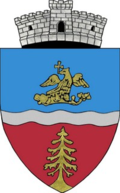Bistra (Alba)
|
Bistra Bisztra |
||||
|
||||
| Basic data | ||||
|---|---|---|---|---|
| State : |
|
|||
| Historical region : | Transylvania | |||
| Circle : | Alba | |||
| Coordinates : | 46 ° 23 ' N , 23 ° 6' E | |||
| Time zone : | EET ( UTC +2) | |||
| Height : | 550 m | |||
| Area : | 118.38 km² | |||
| Residents : | 4,540 (October 20, 2011) | |||
| Population density : | 38 inhabitants per km² | |||
| Postal code : | RO-517115 | |||
| Telephone code : | (+40) 02 58 | |||
| License plate : | FROM | |||
| Structure and administration (as of 2016) | ||||
| Community type : | local community | |||
| Structure : | Bistra, Aroneşti , Băleşti , Băleşti-Catun , Bârleşti , Cheleteni , Ciuldeşti , Creţeşti , Dâmbureni , Dealu Muntelui , Durăşti , Ganesti , Guard , Hodişeşti , Hudriceşti , Lipaia , Lunca Larga , Lunca Merilor , MIHAIESTI , Namas , Novăceşti , Perjeşti , Poiana , Rătitiş , Runcuri , Sălăgeşti , Ștefanca , Țărăneşti , Trişoreşti , Vârşi-Rontu , Vârşii Mari , Vârşii Mici | |||
| Mayor : | Traian Gligor ( PNL ) | |||
| Postal address : | St. Calea Turzii, no. 100 loc. Bistra, jud. Alba, RO-517115 |
|||
| Website : | ||||
Bistra ( German Bistrau , Hungarian Bisztra ) is a Romanian municipality in the Alba district in Transylvania .
location
The village of Bistra is located in the northwest of the Alba district, 5 kilometers east of the city of Câmpeni in the valley of the Arieş on Drum național 75 (Câmpeni– Turda , Kr. Cluj ). 85 kilometers from the district capital Alba Iulia , many of the 34 settlements belonging to the municipality extend on the hills and mountainsides of the surrounding Apuseni Mountains . The community area is 11,838 hectares. Bistra is part of the historic Motzenland .
history
The history of settlement in the region goes back to the late Stone Age . Since the 3rd century BC Were already mined here for gold and silver, which intensified during the time of the Roman occupation. The Romans had a road built from Apulum (today Alba Iulia) into the important gold mining area of Alburnus Maior (today Roșia Montană ), which led through today's town of Bistra. The village was first mentioned in documents in 1437 under kenezius de Byzere . The place name - which is presumably of Slavic origin - is attested to at the beginning of the 14th century. In the 15th century the place belonged to the Bishop of Weißenburg , after the Reformation it belonged to the estate of the place Câmpeni. Today the residents live mainly from cattle breeding, forestry and wood carving.
The narrow-gauge railway Turda-Abrud (93 kilometers), which runs through the town , was put into operation in 1912 and closed in 1998.
population
The population of the entire municipality developed as follows:
| census | Ethnic composition | |||||||
|---|---|---|---|---|---|---|---|---|
| year | population | Romanians | Hungary | German | other | |||
| 1850 | 3,140 | 3.112 | - | 4th | 24 | |||
| 1900 | 3,755 | 3,688 | 8th | 2 | 57 | |||
| 1930 | 4,501 | 4,428 | 13 | 5 | 55 | |||
| 1966 | 5,576 | 5,565 | 7th | - | 4th | |||
| 1977 | 5,688 | 5,614 | 2 | 2 | 70 | |||
| 2002 | 5,066 | 5,045 | - | - | 21st | |||
In 2002, 1,955 of the 5,066 inhabitants of the municipality lived in the village of Bistra itself, the remaining approximately 3,000 in the 33 incorporated villages.
Attractions
- The Naşterea Maicii Domnului Church , which has been owned by the Romanian Orthodox Church since 1948 , until then belonged to the Romanian Greek Catholic Church .
- Monument and plaque for Petru Pavel Aron , (1709–1764) in the center of Bistra. Aron was born in Bistra and was bishop of the Romanian Greek Catholic Church of Blaj and founder of many Romanian schools in Transylvania.
- Memorial plaque for Vasile Ladislau-Fodor (1814–1865), colleague of Avram Iancu .
- Memorial plaque and bust for the composer Nicodim Ganea (1878–1949).
Pictures of Bistra and the surrounding area:
Web links
Individual evidence
- ↑ 2011 census in Romania ( MS Excel ; 1.3 MB)
- ↑ Mayoral elections 2016 in Romania ( MS Excel ; 256 kB)
- ↑ a b c Bistra on sate-comune.ro ( Memento from April 13, 2010 in the Internet Archive )
- ↑ Heinz Heltmann, Gustav Servatius (Ed.): Travel Guide Siebenbürgen. Kraft-Verlag, Würzburg 1993, ISBN 3-8083-2019-2 , p. 138.
- ↑ Pictures of the narrow-gauge railway between Turda and Abrud , on YouTube
- ↑ Census, last updated October 30, 2008, p. 51 (Hungarian; PDF; 1.2 MB)





